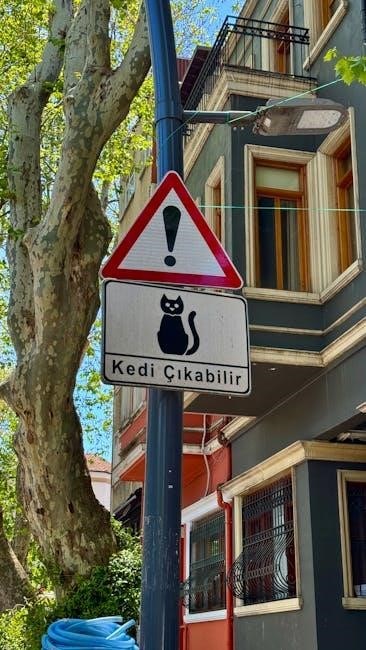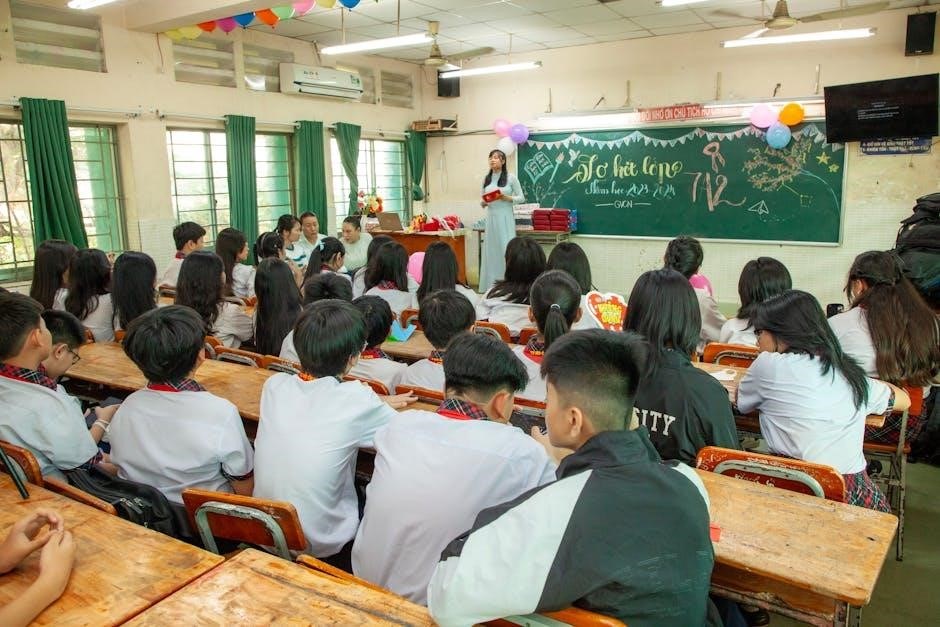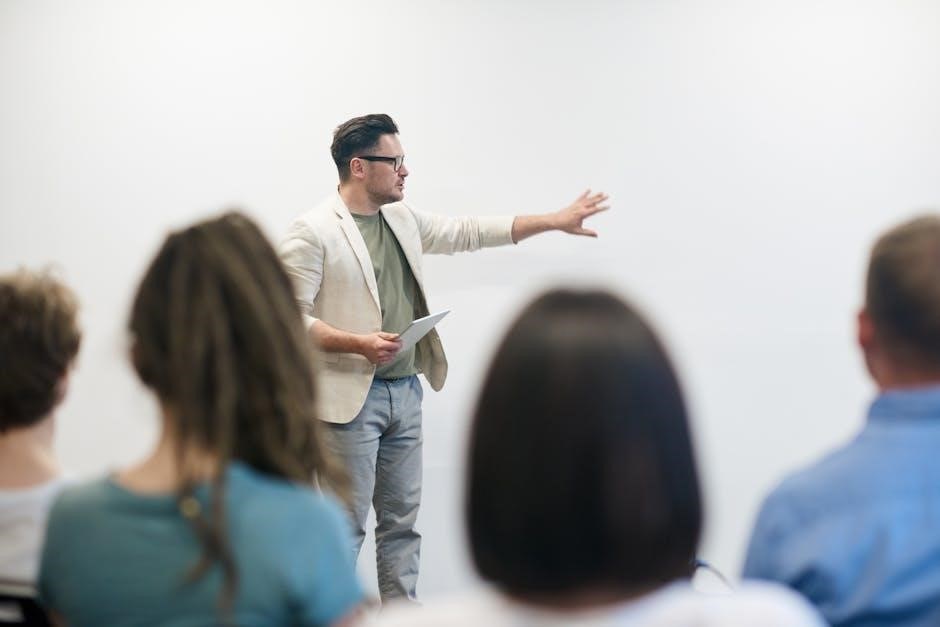
Gagné’s Nine Events of Instruction provide a systematic framework for designing effective learning experiences. This model, developed by Robert Gagné, outlines nine structured steps to engage and guide learners, ensuring optimal learning outcomes. Each event is purposefully designed to support the cognitive and emotional processes necessary for successful knowledge acquisition and retention, aligning with modern educational practices.

Overview of the Model
Gagné’s Nine Events of Instruction is a systematic, research-backed framework designed to guide instructional designers and educators in creating effective learning experiences. The model emphasizes a structured approach to ensure learners engage with content meaningfully, fostering both retention and application of knowledge. Rooted in cognitive psychology, it organizes instruction into nine sequential events, each addressing specific learner needs. This framework is versatile, applicable to various educational settings, from traditional classrooms to digital platforms. By aligning instructional strategies with learner objectives, it ensures clarity and focus, enhancing the overall learning process. The model’s structured yet flexible nature makes it a valuable tool for educators seeking to optimize teaching methods and improve learner outcomes across diverse contexts.

Importance of Structured Instructional Design
Structured instructional design is crucial for ensuring that learning experiences are purposeful and effective. By organizing content and activities systematically, educators can address diverse learner needs and promote deeper understanding. This approach reduces cognitive overload, allowing learners to focus on key concepts. It also enhances retention by providing a clear framework for information acquisition and application. Structured design aligns with Gagné’s Nine Events, ensuring each phase of instruction builds logically on the previous one. This method supports both educators and learners by creating a predictable and effective learning environment, ultimately leading to improved academic and professional outcomes. The clarity and coherence of structured design make it an essential component of modern educational practices.

The Nine Events of Instruction
Gagné’s Nine Events of Instruction are a sequential framework designed to guide learners through a structured and engaging learning process. Each event builds on the previous one, ensuring effective knowledge acquisition and application.
Gaining Attention
Gaining attention is the first event in Gagné’s model, aimed at engaging learners and preparing them for the learning process. This step involves capturing students’ interest to ensure they are mentally present and ready to focus. Techniques such as using surprising facts, storytelling, or thought-provoking questions can effectively draw learners in. Additionally, visual aids like videos or demonstrations can stimulate curiosity and create a receptive environment. The goal is to transition students from their external distractions to a focused, learning-oriented mindset. This event sets the stage for the subsequent steps by ensuring learners are attentive and motivated to engage with the content. Without capturing attention, the remaining instructional events may fail to achieve their intended impact.
Informing Learners of the Objectives
Informing learners of the objectives is the second event in Gagné’s model, serving to clarify the purpose and outcomes of the instruction. This step ensures learners understand what they are expected to achieve by the end of the session. Clear communication of objectives helps students focus their efforts and align their learning with the desired outcomes. Objectives should be specific, measurable, and achievable, providing a roadmap for the content to follow. By transparently sharing goals, instructors help learners prioritize their attention and organize their notes effectively. This step also builds learner commitment and motivation, as knowing the expected outcomes fosters a sense of direction and purpose. Aligning objectives with assessments ensures that learners can evaluate their own progress, making this event crucial for both instruction and learner engagement. Effective communication of objectives sets the foundation for the entire learning experience.
Stimulating Recall of Prior Learning
Stimulating recall of prior learning is the third event in Gagné’s model, designed to activate learners’ existing knowledge and experiences relevant to the new content. This step helps learners connect new information to what they already know, enhancing understanding and retention. Instructors can achieve this through discussions, questions, or examples that relate to the learners’ past experiences. This event is particularly useful at the beginning of a course or lesson, as it bridges the gap between previous learning and the current material. By recalling prior knowledge, learners create a mental framework for integrating new concepts, making the learning process more efficient. This step also reduces cognitive overload by building on familiar ground, ensuring that learners are mentally prepared to engage with the upcoming content. Aligning new information with existing knowledge fosters a deeper and more meaningful learning experience.
Presenting the Content
Presenting the content is the fourth event in Gagné’s model, where instructors deliver the learning material to students. This step involves clearly communicating the information through various methods such as lectures, demonstrations, videos, or readings. The goal is to ensure that the content is organized and presented in a way that aligns with the established learning objectives. Instructors should use strategies to maintain learner engagement, such as varying presentation methods or incorporating visual aids like graphs, infographics, or case studies. This event is critical for ensuring that students receive the necessary information to achieve the desired outcomes. By presenting the content effectively, instructors help learners build a foundation for understanding and applying the material in subsequent steps. The presentation should be structured to promote clarity and relevance, enabling students to process and retain the information successfully. This step is where the actual transfer of knowledge occurs, making it a cornerstone of the instructional process.
Providing Learning Guidance
Providing learning guidance is the fifth event in Gagné’s Nine Events of Instruction, focusing on enhancing learners’ understanding and retention of the presented content. This step involves offering additional support and resources to make the material more meaningful and accessible. Instructors may use supplementary aids like infographics, case studies, videos, or graphs to clarify complex concepts. The goal is to connect new information to learners’ prior knowledge, aligning with constructivist learning principles. By varying teaching methods and incorporating interactive elements, educators can maintain engagement and facilitate deeper comprehension. This event ensures that learners have the tools and context needed to process and retain the information effectively, making it a pivotal part of the instructional process. Through tailored guidance, instructors help learners build a robust foundation for applying the knowledge in future steps. This step emphasizes the importance of meaningful engagement and connection to prior learning, enhancing overall instructional effectiveness.
Eliciting Performance (Practice)
Eliciting performance, or practice, is the sixth event in Gagné’s Nine Events of Instruction, designed to allow learners to apply what they have learned. This step provides learners with opportunities to demonstrate their understanding through activities such as exercises, quizzes, or discussions. The goal is to help learners refine their skills and solidify their knowledge by actively engaging with the content. Instructors should create a supportive environment where mistakes are seen as learning opportunities. Timely feedback is crucial during this phase to guide learners and address any misconceptions. By practicing, learners can bridge the gap between theoretical knowledge and practical application, preparing them for formal assessment. This event ensures that learners are actively involved in the learning process, making it a critical component of effective instruction and skill development. Regular practice reinforces retention and readies learners for real-world application of their skills.
Providing Feedback
Providing feedback is the seventh event in Gagné’s Nine Events of Instruction, serving as a crucial element in the learning process. Feedback is not merely about indicating whether a student’s response is correct or incorrect; it involves guiding learners to understand their performance and identify areas for improvement. This step is essential for reinforcing learning and ensuring that students are on the right track to achieving the learning objectives.
Effective feedback should be timely, specific, and constructive. Immediate feedback is generally more beneficial as it allows learners to address mistakes promptly. However, in some cases, delayed feedback may encourage self-reflection before external input. Feedback should be clear and actionable, highlighting strengths and suggesting specific areas for enhancement.
Technology can facilitate feedback through automated tools, yet human interaction remains vital for nuanced and personalized insights. Additionally, feedback is not a one-way process; learners should also have opportunities to provide input to instructors, fostering a collaborative learning environment.
Ultimately, feedback in Gagné’s model aims to support learners in refining their understanding and skills, reinforcing positive behaviors, and fostering a supportive educational setting where growth and improvement are encouraged.
Assessing Performance
Assessing performance is the eighth event in Gagné’s Nine Events of Instruction, focusing on evaluating learners’ understanding and application of the content. This step ensures that students have achieved the desired learning outcomes and can demonstrate their knowledge or skills effectively. Assessment can take various forms, such as quizzes, tests, projects, or presentations, depending on the learning objectives.
The purpose of this event is to measure the extent to which learners have mastered the material. It provides instructors with insights into the effectiveness of their teaching methods and helps identify areas where additional support may be needed. Multiple assessments are often recommended to ensure a comprehensive understanding of learner progress.
Clear criteria and rubrics are essential to make assessments fair and transparent. This step also serves as a bridge to the final event, enhancing retention and transfer, as it reinforces learning and prepares learners to apply their knowledge in real-world contexts.
Enhancing Retention and Transfer
Enhancing retention and transfer is the final event in Gagné’s model, focusing on helping learners remember and apply what they’ve learned. This step ensures that knowledge is retained in long-term memory and can be used in real-world situations. Techniques like repetition, summaries, and practical applications are effective. Instructors can use supplementary resources such as case studies or simulations to reinforce learning. Relating new information to prior knowledge helps learners retain it better. Feedback after assessments is crucial, as it helps learners understand their progress and solidify their understanding. Activities that encourage both retention and application, such as group projects or problem-solving tasks, are beneficial. This step should be an ongoing process, with quick review sessions or reflective exercises reinforcing learning over time. By integrating these strategies, instructors ensure that learning is not only acquired but also meaningful and applicable beyond the classroom.

Practical Applications of the Nine Events
Gagné’s Nine Events of Instruction are widely applied in both digital and classroom settings to enhance learning experiences. They guide instructors in aligning content with learning objectives, ensuring effective knowledge transfer and retention, and fostering meaningful engagement through structured activities and feedback, ultimately improving educational outcomes for diverse learners.
Aligning Events with Learning Objectives
Aligning Gagné’s Nine Events with learning objectives ensures a structured and intentional approach to teaching, enhancing the effectiveness of instruction. Each event, from gaining attention to enhancing retention, is purposefully directed toward helping students achieve specific learning outcomes. The first event, gaining attention, engages students and prepares them to learn, aligning with the objective of ensuring active participation. Informing learners of the objectives sets clear expectations, directly linking to the learning outcomes. Stimulating recall of prior learning builds on existing knowledge, facilitating easier understanding and retention of new information. Presenting the content delivers the lesson material, which should directly relate to the learning objectives. Providing learning guidance supports students with necessary resources, ensuring they can meet the outcomes. Eliciting performance allows students to apply what they’ve learned, demonstrating their understanding. Providing feedback guides students toward achieving the desired outcomes by highlighting progress and areas for improvement. Assessing performance measures whether students have met the intended outcomes through evaluations like quizzes or projects. Finally, enhancing retention and transfer ensures that learning is not only achieved but also retained and applied in different contexts, aligning with long-term learning goals. This systematic approach creates a focused and adaptable instructional framework, potentially enhanced by digital tools, ensuring that each step supports the achievement of learning objectives.

Using the Events in Digital and Classroom Settings
Gagné’s Nine Events of Instruction are versatile and adaptable to both digital and classroom environments, offering flexibility for diverse teaching contexts. In a classroom setting, instructors can use interactive activities, discussions, and hands-on exercises to engage students. For example, gaining attention can be achieved with a thought-provoking question or a short video, while informing learners of objectives can be done through a clear outline of the lesson’s goals. In digital settings, these events can be implemented using multimedia elements, such as animations or interactive simulations, to present content and stimulate recall of prior learning. Providing learning guidance can involve offering digital resources like hyperlinks or downloadable guides, while eliciting performance can be facilitated through online quizzes or practice exercises. Feedback can be automated or provided through discussion forums, ensuring learners receive timely insights. Assessments can be conducted via online tests or projects, and retention can be enhanced through email reminders or supplementary materials. The adaptability of Gagné’s model ensures effective instruction across various learning environments, making it a valuable tool for modern educators.

Examples of Effective Implementation
A practical example of Gagné’s Nine Events of Instruction can be seen in a mathematics classroom. To teach algebraic equations, the instructor begins by gaining attention with a real-world video showing how algebra solves engineering problems. Next, they inform learners of the objectives, stating that students will solve linear equations by the end of the lesson. To stimulate recall, the teacher reviews basic algebraic concepts from previous lessons. The content is presented using visual aids and step-by-step examples. Learning guidance is provided through small-group practice and one-on-one support. Students then elicit performance by solving problems independently. The teacher provides feedback on their work, highlighting common errors. A short quiz assesses performance, and finally, students apply their skills to real-world problems to enhance retention. This structured approach ensures effective learning and engagement.
Gagné’s Nine Events of Instruction remain a cornerstone in instructional design, offering a systematic approach to enhance learning experiences. Its adaptability ensures educators can deliver meaningful, structured lessons effectively, fostering engagement and retention across diverse settings.
Gagné’s Nine Events of Instruction provide a structured framework for designing effective learning experiences. The model emphasizes gaining attention, stating objectives, and guiding learners through content delivery, practice, feedback, and assessment. It ensures alignment with learning goals, supports retention, and promotes transfer of knowledge to real-world applications. Each event is tailored to engage learners, clarify expectations, and reinforce understanding. This systematic approach is adaptable to various educational settings, making it versatile for both digital and classroom environments. By following these events, educators can create meaningful and impactful instruction that fosters engagement and achieves desired learning outcomes. Gagné’s model remains a cornerstone in instructional design, offering practical strategies to enhance teaching and learning processes across diverse contexts.
Future Directions in Instructional Design

The integration of technology and data analytics is reshaping instructional design, offering new ways to apply Gagné’s Nine Events. Future approaches may focus on personalized learning experiences tailored to individual needs, leveraging AI to adapt content dynamically. Virtual and augmented reality could enhance engagement, aligning with the first event of gaining attention. Additionally, microlearning and gamification may refine how content is presented and practiced, ensuring learners stay motivated. Data-driven assessments will help refine instructional strategies, providing clearer insights into learner performance. Collaborative learning environments and real-world applications of knowledge will also become more prominent, supporting the ninth event of enhancing retention and transfer. By blending Gagné’s timeless principles with modern innovations, instructional design will continue to evolve, creating more effective and engaging learning experiences for diverse audiences.